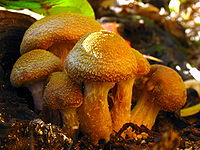
Photo from wikipedia
Abstract Concerns about the health of eastern white pine (Pinus strobus L.) exist throughout its range in the eastern United States due to a variety of causal factors. In the… Click to show full abstract
Abstract Concerns about the health of eastern white pine (Pinus strobus L.) exist throughout its range in the eastern United States due to a variety of causal factors. In the central and southern Appalachian Mountains, a novel and poorly understood dieback phenomenon has been attributed primarily to a scale insect, Matsucoccus macrocicatrices Richards, and a putatively weak fungal pathogen, Caliciopsis pinea Peck. While the nature of this scale-pathogen complex and associated stem and branch cankers is still being explored, quantitative information on the extent of damage to the white pine resource has been lacking. Monitoring plots were established in Virginia and West Virginia beginning in 2012 to assess changes in live and dead volume of white pine. Most sites consisted of uneven aged, mixed oak-pine stands. No significant changes in stand volume were evident, likely because no large trees within the plots died during the study period. Mortality in sapling and pole-sized trees appeared elevated, however. Density dependent mortality associated with natural stand self-thinning was distinguished from density independent mortality associated with the scale-pathogen complex by establishing a baseline mortality for white pine age cohorts. Baseline mortality for each 2-cm diameter class was estimated to be approximately 12% based on the aggregate study site data, and 13–14% based on US Forest Service Forest Inventory and Analysis (FIA) data. Observed mortality within plots was then compared to baseline mortality using chi-square analysis. During the initial measurement years, observed mortality was significantly greater than baseline mortality for only the 4–6 cm diameter class. After 5 years of monitoring, observed mortality was significantly greater than baseline for five diameter classes, including 4–6, 6–8, 8–10, 14–16, and 24–26 cm. The two smallest diameter classes of these five had observed mortality over 30%, on average, while the other three classes averaged over 20% mortality. If these trends continue over time, white pine abundance or sustainability could eventually be compromised as mature trees gradually die and fewer cohorts of young trees are available to replace them.
Journal Title: Forest Ecology and Management
Year Published: 2017
Link to full text (if available)
Share on Social Media: Sign Up to like & get
recommendations!